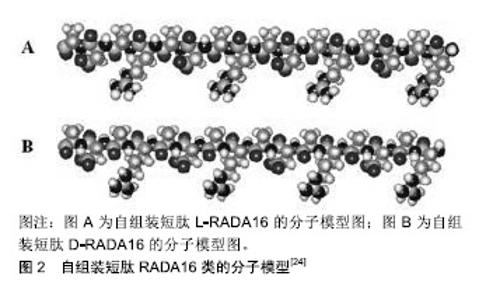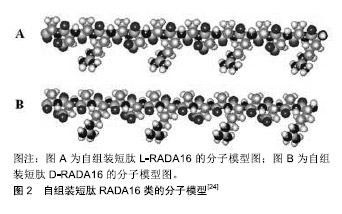Chinese Journal of Tissue Engineering Research ›› 2019, Vol. 23 ›› Issue (34): 5531-5537.doi: 10.3969/j.issn.2095-4344.1446
Previous Articles Next Articles
Self-assembling peptide hydrogels and bone tissue construction
- Key Laboratory of Cell Engineering in Guizhou Province, Affiliated Hospital of Zunyi Medical University, Zunyi 563003, Guizhou Province, China
-
Received:2019-05-30Online:2019-12-08Published:2019-12-08 -
Contact:Liu Yanfei, PhD, Associate researcher, Master’s supervisor, Key Laboratory of Cell Engineering in Guizhou Province, Affiliated Hospital of Zunyi Medical University, Zunyi 563003, Guizhou Province, China -
About author:Xiong Na, Master candidate, Key Laboratory of Cell Engineering in Guizhou Province, Affiliated Hospital of Zunyi Medical University, Zunyi 563003, Guizhou Province, China -
Supported by:Project of the Health and Family Planning Commission of Guizhou Province, No. Gzwjkj2017-1-036 (to LYF); the Natural Science Research Project of Education Department of Guizhou Province, No. Qianjiaohe-KY[2015]418 (to LYF)
CLC Number:
Cite this article
Xiong Na, Liu Yanfei, Wei Wei . Self-assembling peptide hydrogels and bone tissue construction[J]. Chinese Journal of Tissue Engineering Research, 2019, 23(34): 5531-5537.
share this article

2.1 RADA16支架材料 2.1.1 RADA16的特性 自组装短肽最初由Zhang等[14]在zuotin蛋白中发现,研究表明当短肽暴露于生理介质或盐溶液中时会自发通过非共价作用力(疏水作用、氢键、静电作用、范德华力等)形成二级结构,其中β-折叠结构是最常见且应用最广泛的二级结构。由Yokoi等[15]设计的RADA16-I在自组装短肽中最具代表性,RADA16([COCH3]-RADARADARADARADA-[CONH2])由16个天然L-氨基酸残基(天冬氨酸残基、精氨酸残基和丙氨酸残基)相互交替排列组成[16],天冬氨酸残基与精氨酸残基之间的静电作用力和精氨酸残基的疏水作用力使其堆叠形成直径为8-10 nm、孔径为5-200 nm的纳米纤维,随后聚合形成含水量超过99%的水凝胶支架。 经β折叠形成的自组装短肽水凝胶支架能够为细胞的黏附、增殖和分化提供稳定的三维环境,并且拥有表面积大、含水量高和组织相容性良好等优势,近年来这类短肽水凝胶被广泛用于生物医学领域,如组织工程、药物缓释、止血和伤口愈合等[17]。其中RADA16已被批准作为商业产品PuraMatrix(PM)应用于实验室和临床研究工作,是目前组织工程应用广泛的一类新兴材料。在骨组织工程领域内,自组装短肽水凝胶对间充质干细胞和小鼠胚胎成骨细胞前体细胞MC3T3-E1及其他种子细胞的黏附、增殖、成骨分化有显著增强作用,表明这类支架材料对种子细胞增殖和成骨分化的促进作用,为自组装短肽应用于修复骨缺损提供了理论依据和实验基础。 2.1.2 RADA16在骨组织工程中的应用 张锋等[18]研究显示,MC3T3-E1细胞在RADA16表面生长一段时间后碱性磷酸酶、骨钙素和钙化结节表达含量增加,并且实时荧光定量PCR检测到成骨分化相关基因Runx-2、OSX、AKP-2和骨钙素的高表达并随着培养时间的增长而增多,其中Runx2与OSX不仅影响成骨细胞的分化,而且也调节成骨细胞的功能。总而言之,RADA16水凝胶支架能够促进MC3T3-E1细胞的黏附、伸展和增殖,增强成骨分化和功能表达,且水凝胶可形成任意的形态并具备良好的生物相容性。Chen等[19]设计了全由D型-氨基酸构成的D-RADA16肽水凝胶,圆二色光谱显示D-RADA16采用典型的β折叠结构,并且和L-RADA16是对映体。β折叠结构具有纳米纤维形成的能力并为细胞骨架提供支持,因此是非常必需 的[20]。将SD大鼠骨髓间充质干细胞在1.25-10 g/L质量浓度的支架上培养,检测骨髓间充质干细胞的增殖速率,结果表明与1.25,2.5 g/L相比,5.0,10.0 g/L的肽溶液能够促进细胞增殖,推测其可能原因是在低浓度的肽溶液中没有足够数量的纳米纤维形成3D环境,因此它与传统2D培养相似,不能模拟细胞生长的细胞外环境。虽然在目前的实验条件下D-RADA16支架在体外不能促进骨髓间充质干细胞的成骨分化,但能够提高细胞的迁移。另外最重要的是与L-RADA16支架相比,D-RADA16支架对蛋白酶K表现出更高的蛋白水解抗性。这些观察结果表明D-RADA16水凝胶支架具有优异的生物活性、生物相容性和生物稳定性,有希望作为体内长期应用的候选者。 在新西兰兔髂骨缺损模型中,Wu等[21]研究表明RADA16-I有修复骨缺损和快速止血的能力,当用RADA16-I治疗时,髂骨缺损的边缘变得模糊,缺损处充满成骨细胞、类骨质和新形成的骨基质,缺损面积逐渐减少,且RADA16-I治疗组中未见炎症细胞的浸润;而骨蜡处理组没有明显的骨再生,仍可见缺损并出现中度炎症反应。Hayashi等[22]将PuraMatrix水凝胶携带的人诱导多能干细胞移植到大鼠颅骨缺损中,结果观察到骨缺损的侧缘处形成均匀的骨,在缺损区域可见纤维组织,包括成骨细胞和一些新的骨组织,再生骨周围有许多毛细血管形成;并发现水凝胶能够促进血管内皮细胞的浸入,可有效解决骨组织工程中的血液供应这一主要问题,但免疫排斥仍是移植人诱导多能干细胞亟待解决的重要问题。Tcacencu等[23]将接种到自组装肽水凝胶上的人间充质干细胞与胶原海绵联合植入大鼠右下颌骨缺损中,观察到牙槽骨的骨体积密度明显升高,第一磨牙牙根周围骨组织中的破骨细胞数显著减少,而且没有产生局部炎症反应和肿瘤样物质。 2.1.3 RADA16联合细胞因子在骨组织工程中的应用细胞因子参与构成组织工程,并能够促进种子细胞的发育、生长、增殖和分化,自组装短肽水凝胶联合细胞因子能够为细胞生长提供适宜的微环境[10]。在SD大鼠股骨髁缺损的模型上,He等[24]收获了SD大鼠股骨髁,与PBS处理组相比其骨形态变化表明,L-RADA16肽水凝胶、D-RADA16肽水凝胶和包裹碱性成纤维细胞生长因子的D-RADA16肽水凝胶的3个实验组在8周时均发现了明显的新生骨组织形成,见图2。其中D-RADA16水凝胶在储存和释放碱性成纤维细胞生长因子方面显示出一定的潜力,Micro-CT分析表明碱性成纤维细胞生长因子能够进一步促进骨再生。除碱性成纤维细胞生长因子外,骨形态发生蛋白2是骨组织工程中考虑最多的另一种细胞因子,其能够刺激成骨细胞募集、新骨形成和血管生成[25]。Phipps等[26]以RADA16为载体在股骨头坏死的仔猪模型中局部输注骨形态发生蛋白2,结果表明RADA16在输注到股骨头后从溶液转变为凝胶状,有效防止了骨形态发生蛋白2的回流,并可避免在髋关节囊内产生异位骨化。从RADA16释放的骨形态发生蛋白2仍具有良好的生物活性,能诱导猪原代骨髓基质细胞中SMAD1/5/8的磷酸化,并且浓度为0.25%和0.75%的RADA16能最佳地控制体外骨形态发生蛋白2的释放并刺激骨髓间充质干细胞的生长。Ikeno等[27]在家兔颅骨模型中使用具有重组人骨形态发生蛋白2的自组装肽水凝胶支架对骨再生进行组织学评价,8周后证明与重组人骨形态发生蛋白2联合RADA16-I组的再生组织面积明显增加。"


2.2 RADA16衍生支架材料 经典RADA16虽有良好的成胶性,但其具有非常低的pH值(3.0-4.0),有损伤包裹细胞和宿主组织的潜在可能[28]。因此设计出生物素、蛋白序列和细胞外基质模拟序列等功能基团,并将其与RADA16中的C或者N末端进行共价结合,进一步设计出具备更高生物活性、更高机械强度的材料。 Chen等[29]将功能基序RGD连接在RADA16水凝胶上形成RADA16-RGD,该支架可自组装成交织的纳米纤维结构。研究表明RADA16-RGD和RADA16混合形成的材料,能够促进MC3T3-E1细胞的黏附、扩散、增殖和成骨分化。He等[30]将RGD结合在D-RADA16上形成D-RADA16-RGD,D-RADA16-RGD肽溶液能够自组装成耐用的水凝胶膜;在雌性SD大鼠股骨髁骨缺损模型中,Micro-CT的2D重建和量化分析(即骨体积分数、骨密度和骨小梁厚度)及组织学研究表明,D-RADA16-RGD肽水凝胶能够明显提高骨愈合促进骨再生。 Horii等[31]选择成骨生长肽衍生基序(ALK:ALKRQGRTLYGF)、骨桥蛋白细胞粘附基序(DGR:DGRGDSVAYG)和生物模拟设计的双单位RGD结合序列(PRG:PRGDSGYRGDS)3个肽基序,将其连接在RADA16的羧基末端,其中成骨生长肽(OGP)能够刺激成骨细胞的增殖和分化,提高碱性磷酸酶的活性[32];骨桥蛋白具有调节细胞黏附、迁移、存活、NF-κB活性、NO合成和钙晶体形成的功能;细胞黏附基序(DGRGDSVAYG)含有RGD序列,可显著改善体内和体外的骨形成。研究证实这类功能化肽支架可有效促进骨细胞增殖和MC3T3-E1细胞的成骨分化。相较于ALK和DGR支架,PRG支架中的细胞产生更高浓度的骨钙蛋白和更高活性的碱性磷酸酶,更高浓度的PRG能够刺激细胞迁移到3D肽纳米纤维支架中,这为新型支架材料与种子细胞结合更好地应用于骨组织工程提供了一种新的解决方案。 赵刚等[33]将多肽短链NBD结合于自组装短肽RADA16上获得新型功自组装多肽NBD/RADA16,分别在RADA16水凝胶和NBD/RADA16水凝胶中培养MC3T3-E1 细胞,观察到MC3T3-E1细胞在新型水凝胶上快速生长,状态良好,胞浆透明,无代谢产物堆积;碱性磷酸酶活性增加并随时间的增长表现出递增趋势;并有更为明显的钙沉积表达。在NBD/RADA16水凝胶中MC3T3-E1细胞的骨形态发生蛋白2表达水平升高,为骨髓间充质干细胞和MC3T3-E1细胞的趋向、聚集、分化提供了良好的化学刺激和微环境。 Tao等[34]研究在RADA16-I的C末端分别连接功能序列KPSS、SNVI和KAIS以形成自组装多肽RAD/KPS、RAD/SNV和RAD/KAI,结果发现在促进人髓核细胞增殖、迁移及表达细胞外基质成分方面,RAD/KPS较RAD/SNV和RAD/KAI有明显的优势。其中短肽KPSS、SNVI、KAIS是骨形态发生蛋白7的3个功能活性片段,骨形态发生蛋白7可以增加体外成骨细胞如细胞中Ⅱ型胶原蛋白和骨钙蛋白的产生,改善骨髓间充质干细胞形成矿化骨结节,同时对髓核细胞分泌蛋白多糖有一定的促进作用。由于RADA16-I直接与KPSS序列形成的多肽RKPS成胶性能较差,因此刘龙刚等[35]将RKPS与RADA16-I等体积混合形成混合支架材料RADKPS。RADKPS可很好地交织成直径为10-40 nm、孔径在5-200 nm之间并含有大于99%水的3D纳米纤维网络,可通过微创方式注入髓核组织。生长在RADKPS上的骨髓间充质干细胞细胞呈长梭形、漩涡样生长,细胞增殖能力随多肽溶液浓度增加呈递增趋势;不同浓度 RADKPS溶液相对溶血率均<5%,完全符合医用材料对溶血实验的要求;评价植入小鼠皮下的支架观察局部炎性反应及降解速度,组织学结果显示在 14 d 内以少量中性粒细胞浸润为主,28 d 时以成纤维细胞浸润为主。成纤维细胞分泌大量胶原纤维,已逐步取代原支架结构,表明支架的降解速率与新骨生成的速率相一致且降解产物对机体无毒害。综上,修饰有骨形态发生蛋白7功能片段的RADKPS水凝胶具有良好的细胞相容性、血液相容性及组织相容性,为进一步动物实验验证其具有修复椎间盘的作用和治疗骨缺损奠定了实验基础。 Osteostatin(TRSAW)是甲状旁腺类激素相关蛋白(PTHrP)的C端结构域。Osteostatin能通过介导甲状旁腺激素/甲状旁腺类激素相关蛋白受体非相关性受体,在体外促进成骨前体细胞分化和生长。陈贝克等[36]将Osteostatin与RADA16-I的C末端相连形成新型多肽RADA16/TRSAW,结果表明RADA16/TRSAW仅能形成半凝胶状态,原子力显微镜下多肽呈粗细不均匀的斑片状纤维,可能原因为功能化的多肽序列影响β折叠。将RADA16/TRSAW与RADA16-I等体积混合为TRSAWmx水凝胶,发现TRSAWmx具备良好的成胶性和自组装性,并且可明显提高MC3T3-E1细胞的碱性磷酸酶、骨钙蛋白和血管内皮生长因子基因表达量。 作为同种异体骨移植物的脱矿骨基质,有充足的来源但缺乏骨诱导性。因此,Li等[37]用脱矿骨基质联合自组装短肽RADA16-I形成复合支架SAP/脱矿骨基质,在山羊股骨缺损中观察到骨髓间充质干细胞在复合支架中碱性磷酸酶、骨钙蛋白和Runx2基因的表达均高于脱矿骨基质组。该材料对骨髓间充质干细胞成骨分化的促进作用,可为骨缺损提供更有效的成骨再生策略。Hou等[38]研究证实在RADA16-I的末端连接脱矿骨基质形成的复合支架SAP/脱矿骨基质平均孔径减至20.22 μm,而脱矿骨基质支架平均孔径为396.24 μm。X射线光电子能谱分析和环境扫描电子显微镜显示自组装短肽可改变脱矿骨基质支架的表面和内部微结构,而复合支架对细胞的富集产量也因孔径的减少而得到提高。此外,SAP/脱矿骨基质支架可明显增加富集细胞中有核细胞的比率,同时支架中的RADA16-I可提供更多的细胞黏附位点。在无胸腺小鼠模型中植入双侧髂骨骨膜后,与脱矿骨基质治疗组相比,SAP/脱矿骨基质复合支架组可形成更多的新生骨,并检测到骨形态发生蛋白6、血小板衍生生长因子BB、血管内皮生长因子和表皮生长因子浓度增加,而脱矿骨基质支架只对表皮生长因子有富集作用。总之,SAP/脱矿骨基质复合支架可通过调控种子细胞的微环境,为种子细胞的增殖分化提供良好的三维环境。 2.3 其他新型自组装短肽支架材料 随着经典RADA16水凝胶在骨组织工程中的应用被不断开发,新型离子互补自组装短肽材料也被相继研发。Wan等[39]设计的离子互补短肽FEFEFKFK在溶液中也能够自组装成β折叠纳米纤维,并最终形成水凝胶。包裹在FEFEFKFK水凝胶内的牛关节软骨细胞可增殖并产生软骨细胞外基质的组分Ⅱ型胶原,用以治疗退行性椎间盘疾病和下背痛。 Tripathi等[40]通过在自组装肽KLD-12(KLD)的N-末端加上含有可变数量的阳离子精氨酸残基,设计了4种KLD变体,研究证明KLD及其变体KLD-2R和KLD-3R促进矿化结节形成并诱导成骨基因(Runx2和Ⅰ型胶原)的表达。同时KLD-2R和KLD-3R也显示出显著的抗菌活性,能够预防材料使用中的继发感染;KLD-2R对骨折部位骨再生的促进作用随剂量的增加而增高,在250 μg剂量下显示出比原始自组装肽KLD更高的碱性磷酸酶活性;而KLD-3R能够更好的促进矿化基质沉积。 Quan等[41]以骨形态发生蛋白2仿生肽(BMPBP)为基础设计了2种肽水凝胶,分别是D9 KIPKASSVPTELS AISRGDS(DSR)和D9 KIPKASS (p)VPTELSAISRGDS (DSpR),其中骨形态发生蛋白2仿生肽是天然骨形态发生蛋白2的替代品,可通过与Ⅰ型和Ⅱ型骨形态发生蛋白受体的相互作用显著提高碱性磷酸酶活性和骨钙素表达。将2种肽植入颅骨缺损的SD大鼠,观察到DSR组和DSpR组在缺损区域周围的骨形成明显多于对照组,但骨再生只出现在支架的表面上,两组骨体积分数值也相近。用DSpR水凝胶包裹大鼠骨髓间充质干细胞后,从缺损边缘到中心区域均发现了骨样结构,骨体积分数值也显著升高。利用支架中骨形态发生蛋白2仿生肽对骨髓间充质干细胞成骨分化的加快作用,该支架能够增强成骨标志物的表达,并促进骨缺损愈合后期的骨骼成熟。 Tsukamoto等[42]证明在具有成骨诱导培养基的SPG-178-Gel水凝胶中培养牙髓干细胞,发现骨桥蛋白、骨钙蛋白和Ⅰ型胶原蛋白的表达增加,Micro-CT观察显示广泛的钙沉积形成,表明在大鼠颅骨缺损模型中SPG-178-Gel可用于牙髓干细胞的高效成骨诱导并促进骨再生。Ando等[43]用SPG-178水凝胶填充聚醚醚酮材料来增强其机械强度,发现SPG-178在体外能够提高骨生成中骨标记基因碱性磷酸酶、骨形态发生蛋白2和骨钙蛋白、骨桥蛋白、骨涎蛋白及Osterix的mRNA水平表达的增加,在体内可显著改善骨愈合。这些结果证明该水凝胶能够通过诱导骨传导因子作为促骨生成的支架。 骨组织工程中的自组装短肽见表1。 "

| [1]Feuvrier D,Sagawa Y Jr,Beliard S,et al.Long-term donor-site morbidity after vascularized free fibula flap harvesting: Clinical and gait analysis. J Plast Reconstr Aesthet Surg. 2016;69(2): 262-269.[2]Lee SS, Huang BJ,Kaltz SR,et al. Bone regeneration with low dose BMP-2 amplified by biomimetic supramolecular nanofibers within collagen scaffolds. Biomaterials. 2013;34(2):452-459.[3]Kashte S,Jaiswal AK,Kadam S.Artificial bone via bone tissue engineering: Current scenario and challenges.Tissue Eng Regen Med.2017;14(1):1-14.[4]Quarto R,Giannoni P.Bone tissue engineering: Past-Present-Future. Methods Mol Biol.2016;1416:21-33.[5]Roddy E,DeBaun MR,Daoud-Gray A,et al.Treatment of critical-sized bone defects: clinical and tissue engineering perspectives.Eur J Orthop Surg Traumatol. 2018;28(3): 351-362.[6]Zhang Y,Fu C,Li Y,et al.Synthesis of an injectable, self-healable and dual responsive hydrogel for drug delivery and 3D cell cultivation.Polym Chem.2017;8(3):537-544.[7]Iwata T,Yamato M,Ishikawa I,et al.Tissue engineering in periodontal tissue.Anat Rec (Hoboken). 2014;297(1):16-25.[8]Chia HN,Wu BM.Recent advances in 3D printing of biomaterials.J Biol Eng.2015;9:4.[9]Roseti L,Parisi V,Petretta M,et al.Scaffolds for bone tissue engineering: State of the art and new perspectives.Mater Sci Eng C Mater Biol Appl.2017;78:1246-1262.[10]Velasco MA,Narvaez-Tovar CA,Garzon-Alvarado DA.Design,materials,and mechanobiology of biodegradable scaffolds for bone tissue engineering.Biomed Res Int. 2015; 2015:729076.[11]Soundarya SP,Menon AH,Chandran SV,et al. Bone tissue engineering: Scaffold preparation using chitosan and other biomaterials with different design and fabrication techniques. Int J Biol Macromol. 2018;119:1228-1239.[12]Ruan SQ,Yan L,Deng J,et al.Preparation of a biphase composite scaffold and its application in tissue engineering for femoral osteochondral defects in rabbits.Int Orthop. 2017; 41(9):1899-1908.[13]Shadjou N,Hasanzadeh M,Khalilzadeh B.Graphene based scaffolds on bone tissue engineering. Bioengineered. 2018; 9(1):38-47.[14]Zhang S,Holmes T,Lockshin C,et al.Spontaneous assembly of a self-complementary oligopeptide to form a stable macroscopic membrane.Proc Natl Acad Sci USA. 1993;90(8): 3334-3338.[15]Yokoi H,Kinoshita T,Zhang S.Dynamic reassembly of peptide RADA16 nanofiber scaffold. Proc Natl Acad Sci USA. 2005; 102(24):8414-8419.[16]Tian X,Sun F,Zhou XR,et al.Role of peptide self-assembly in antimicrobial peptides.J Pept Sci. 2015;21(7):530-539.[17]Rad-Malekshahi M,Lempsink L,Amidi M,et al.Biomedical applications of self-assembling peptides. Bioconjug Chem. 2016;27(1):3-18.[18]张锋,任灵飞,应永芳,等.成骨细胞在精-丙-天-丙16自组装多肽水凝胶表面培养的研究[J].医学研究杂志.2012,41(10):72-75.[19]Chen S,Zhou A,He B,et al.Designer D-form self-assembling peptide scaffolds promote the proliferation and migration of rat bone marrow-derived mesenchymal stem cells.Int J Mol Med. 2017;40(3):679-688.[20]Tavakol S,Saber R,Hoveizi E,et al.Chimeric Self-assembling Nanofiber Containing Bone Marrow Homing Peptide's Motif Induces Motor Neuron Recovery in Animal Model of Chronic Spinal Cord Injury; an In Vitro and In Vivo Investigation.Mol Neurobiol.2016;53(5):3298-3308.[21]Wu M,Ye Z,Zhu H,et al.Self-assembling peptide Nanofibrous hydrogel on immediate hemostasis and accelerative osteosis. Biomacromolecules.2015;16(10);3112-3118.[22]Hayashi K,Ochiai-Shino H,Shiga T,et al.Transplantation of human-induced pluripotent stem cells carried by self-assembling peptide nanofiber hydrogel improves bone regeneration in rat calvarial bone defects.BDJ Open. 2016;2: 15007.[23]Tcacencu I,Karlstrom E,Cedervall J,et al.Transplanted human bone marrow mesenchymal stem cells seeded onto peptide hydrogel decrease alveolar bone loss.Biores Open Access 2012;1(5):215-221.[24]He B,Ou Y,Chen S,et al.Designer bFGF-incorporated d-form self-assembly peptide nanofiber scaffolds to promote bone repair.Mater Sci Eng C Mater Biol Appl 2017;74:451-458.[25]Zhang Y, Yang W,Devit A,et al.Efficiency of coculture with angiogenic cells or physiological BMP-2 administration on improving osteogenic differentiation and bone formation of MSCs. J Biomed Mater Res A.2019;107(3):643-653.[26]Phipps MC,Monte F,Mehta M,et al.Intraosseous delivery of bone morphogenic protein-2 using a self-assembling peptide hydrogel.Biomacromolecules 2016;17(7):2329-2336.[27]Ikeno M,Hibi H,Kinoshita K,et al.Effects of self-assembling peptide hydrogel scaffold on bone regeneration with recombinant human bone morphogenetic protein-2.Int J Oral Maxillofac Implants. 2013;28(5):e283-289.[28]Nagai Y,Yokoi H,Kaihara K,et al.The mechanical stimulation of cells in 3D culture within a self-assembling peptide hydrogel. Biomaterials.2012;33(4):1044-1051.[29]Chen X,Zhou A,Zhao W,et al.Functionalized self-assembling peptide nanofiber scaffolds for culturing mc3t3-e1 cells.Dig J Nanomater Biostruct.2017;12(2):605-613.[30]He B,Ou Y,Zhou A,et al.Functionalized D-form self-assembling peptide hydrogels for bone regeneration. Drug Des Devel Ther.2016;10:1379-1388.[31]Horii A,Wang X,Gelain F,et al.Biological designer self-assembling peptide nanofiber scaffolds significantly enhance osteoblast proliferation,differentiation and 3-D migration. PLoS One. 2007;2(2):e190.[32]Pigossi SC, Medeiros MC, Saska S, et al. Role of osteogenic growth peptide (OGP) and OGP(10-14) in bone regeneration:A Review. Int J Mol Sci. 2016;17(11):1885.[33]赵刚,李京玲,王丹,等.新型自组装水凝胶NBD/RADA16可促进前成骨细胞的分化[J].中国组织工程研究, 2014,18(21): 3329-3333.[34]Tao H,Zhang Y,Wang CF,et al.Biological evaluation of human degenerated nucleus pulposus cells in functionalized self-assembling peptide nanofiber hydrogel scaffold.Tissue Eng Part A. 2014;20(11-12):1621-1631.[35]刘龙刚,伍耀宏,陶晖,等.修饰有BMP-7功能片段的功能化自组装多肽纳米纤维水凝胶RADKPS制备及其生物相容性研究[J].中国修复重建外科杂志,2016,30(4):491-498.[36]陈贝克,侯天勇,刘健,等.新型自组装多肽水凝胶对成骨细胞前体细胞作用的体外研究[J].第三军医大学学报, 2016,38(8): 817-823.[37]Li Z,Hou T,Luo F,et al.Bone marrow enriched graft, modified by self-assembly peptide, repairs critically-sized femur defects in goats.Int Orthop.2014;38(11):2391-2398.[38]Hou T, Li Z, Luo F, et al. A composite demineralized bone matrix-self assembling peptide scaffold for enhancing cell and growth factor activity in bone marrow. Biomaterials. 2014;35(22):5689-5699.[39]Wan S,Borland S,Richardson SM,et al.Self-assembling peptide hydrogel for intervertebral disc tissue engineering. Acta Biomater.2016;46:29-40.[40]Tripathi JK,Pal S,Awasthi B,et al.Variants of self-assembling peptide, KLD-12 that show both rapid fracture healing and antimicrobial properties.Biomaterials.2015;56:92-103.[41]Quan C,Zhang Z,Liang P,et al.Bioactive gel self-assembled from phosphorylate biomimetic peptide: A potential scaffold for enhanced osteogenesis.Int J Biol Macromol. 2019;121: 1054-1060.[42]Tsukamoto J,Naruse K,Nagai Y,et al.Efficacy of a self-assembling peptide hydrogel, SPG-178-Gel, for bone regeneration and three-dimensional osteogenic induction of dental pulp stem cells.Tissue Eng Part A. 2017;23(23-24): 1394-1402.[43]Ando K,Imagama S,Kobayashi K,et al.Effects of a self-assembling peptide as a scaffold on bone formation in a defect.PLoS One.2018;13(1):e0190833. |
| [1] | Lin Qingfan, Xie Yixin, Chen Wanqing, Ye Zhenzhong, Chen Youfang. Human placenta-derived mesenchymal stem cell conditioned medium can upregulate BeWo cell viability and zonula occludens expression under hypoxia [J]. Chinese Journal of Tissue Engineering Research, 2021, 25(在线): 4970-4975. |
| [2] | Pu Rui, Chen Ziyang, Yuan Lingyan. Characteristics and effects of exosomes from different cell sources in cardioprotection [J]. Chinese Journal of Tissue Engineering Research, 2021, 25(在线): 1-. |
| [3] | Zhang Xiumei, Zhai Yunkai, Zhao Jie, Zhao Meng. Research hotspots of organoid models in recent 10 years: a search in domestic and foreign databases [J]. Chinese Journal of Tissue Engineering Research, 2021, 25(8): 1249-1255. |
| [4] | Wang Zhengdong, Huang Na, Chen Jingxian, Zheng Zuobing, Hu Xinyu, Li Mei, Su Xiao, Su Xuesen, Yan Nan. Inhibitory effects of sodium butyrate on microglial activation and expression of inflammatory factors induced by fluorosis [J]. Chinese Journal of Tissue Engineering Research, 2021, 25(7): 1075-1080. |
| [5] | Wang Xianyao, Guan Yalin, Liu Zhongshan. Strategies for improving the therapeutic efficacy of mesenchymal stem cells in the treatment of nonhealing wounds [J]. Chinese Journal of Tissue Engineering Research, 2021, 25(7): 1081-1087. |
| [6] | Liao Chengcheng, An Jiaxing, Tan Zhangxue, Wang Qian, Liu Jianguo. Therapeutic target and application prospects of oral squamous cell carcinoma stem cells [J]. Chinese Journal of Tissue Engineering Research, 2021, 25(7): 1096-1103. |
| [7] | Xie Wenjia, Xia Tianjiao, Zhou Qingyun, Liu Yujia, Gu Xiaoping. Role of microglia-mediated neuronal injury in neurodegenerative diseases [J]. Chinese Journal of Tissue Engineering Research, 2021, 25(7): 1109-1115. |
| [8] | Li Shanshan, Guo Xiaoxiao, You Ran, Yang Xiufen, Zhao Lu, Chen Xi, Wang Yanling. Photoreceptor cell replacement therapy for retinal degeneration diseases [J]. Chinese Journal of Tissue Engineering Research, 2021, 25(7): 1116-1121. |
| [9] | Jiao Hui, Zhang Yining, Song Yuqing, Lin Yu, Wang Xiuli. Advances in research and application of breast cancer organoids [J]. Chinese Journal of Tissue Engineering Research, 2021, 25(7): 1122-1128. |
| [10] | Wang Shiqi, Zhang Jinsheng. Effects of Chinese medicine on proliferation, differentiation and aging of bone marrow mesenchymal stem cells regulating ischemia-hypoxia microenvironment [J]. Chinese Journal of Tissue Engineering Research, 2021, 25(7): 1129-1134. |
| [11] | Zeng Yanhua, Hao Yanlei. In vitro culture and purification of Schwann cells: a systematic review [J]. Chinese Journal of Tissue Engineering Research, 2021, 25(7): 1135-1141. |
| [12] | Kong Desheng, He Jingjing, Feng Baofeng, Guo Ruiyun, Asiamah Ernest Amponsah, Lü Fei, Zhang Shuhan, Zhang Xiaolin, Ma Jun, Cui Huixian. Efficacy of mesenchymal stem cells in the spinal cord injury of large animal models: a meta-analysis [J]. Chinese Journal of Tissue Engineering Research, 2021, 25(7): 1142-1148. |
| [13] | Hou Jingying, Yu Menglei, Guo Tianzhu, Long Huibao, Wu Hao. Hypoxia preconditioning promotes bone marrow mesenchymal stem cells survival and vascularization through the activation of HIF-1α/MALAT1/VEGFA pathway [J]. Chinese Journal of Tissue Engineering Research, 2021, 25(7): 985-990. |
| [14] | Shi Yangyang, Qin Yingfei, Wu Fuling, He Xiao, Zhang Xuejing. Pretreatment of placental mesenchymal stem cells to prevent bronchiolitis in mice [J]. Chinese Journal of Tissue Engineering Research, 2021, 25(7): 991-995. |
| [15] | Liang Xueqi, Guo Lijiao, Chen Hejie, Wu Jie, Sun Yaqi, Xing Zhikun, Zou Hailiang, Chen Xueling, Wu Xiangwei. Alveolar echinococcosis protoscolices inhibits the differentiation of bone marrow mesenchymal stem cells into fibroblasts [J]. Chinese Journal of Tissue Engineering Research, 2021, 25(7): 996-1001. |
| Viewed | ||||||
|
Full text |
|
|||||
|
Abstract |
|
|||||